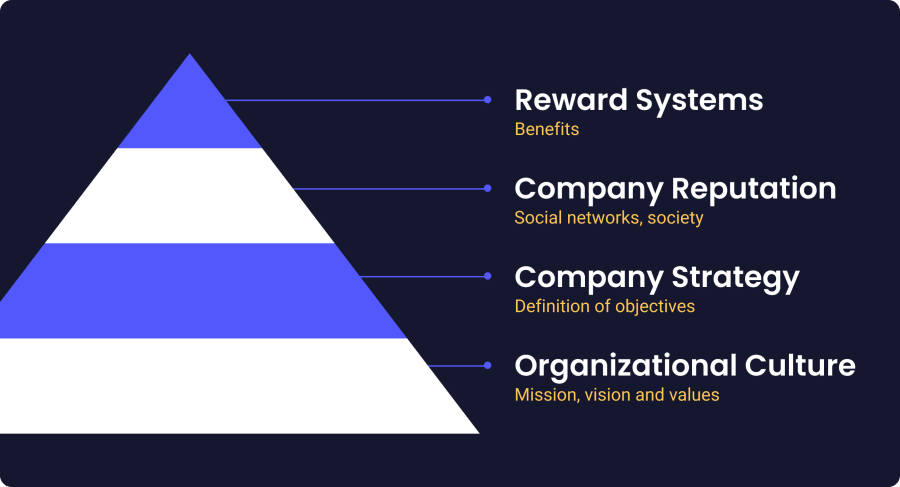NEW
Proxify is bringing transparency to tech team performance based on research conducted at Stanford. An industry first, built for engineering leaders.
Learn more
Hiring & Retention
Company culture
Apr 26, 2022 · 9 min read
What is employer branding & why is it important?
A company’s reputation is an important part of company identity, and building up that reputation is the first step toward creating robust employer branding.
Adrijan Arsovski
Content Writer
Verified author

The digital marketplace, especially in 2023, is a noisy jungle. Everyone, their brand and their grandmother are fighting to take what they think is their rightful place under the sun, inching away (“centimeter-ing” for the metric users out there) at free or paid server space with impeccable zeal.
And just like in a real jungle, the winners usually eat the losers 99% of the time. It’s a macrocosm of Maslow’s hierarchy of needs, Pavlovian conditioning, and Dawkins’ meme theory all lumped together into one big ball of indigestible hexadecimal mincemeat.
In other words, it’s pure chaos.
This is why I took it upon myself to clear out the misconceptions behind employer branding, how to define it, and how to attract and retain the best talent without breaking the bank – and more importantly – without breaking the brain.
What exactly is employer branding?
Employer branding means building and nurturing your company’s reputation among your existing employees, active job seekers and major stakeholders if applicable. In other words, it’s the notion of how everyone perceives your organization that comes from the people that work in that same organization.

It entails everything that you do to place your organization above the competition as the best workplace of choice.
But what exactly does it mean to nurture a positive employer reputation? Well, for one, it means that your employees will speak positively about your business when you’re not around. It’s the gossip about the workplace that can be overheard both inside and outside your organization.
It may sound like a distant, intangible abstraction, but a company’s reputation is a powerful asset that should be nurtured, cultivated, and taken care of constantly.
And this is where a powerful employer branding strategy comes into play.
Boost your team
Proxify developers are a powerful extension of your team, consistently delivering expert solutions. With a proven track record across 500+ industries, our specialists integrate seamlessly into your projects, helping you fast-track your roadmap and drive lasting success.
Why is employer branding important?
Employer branding is very important. The concept itself has been present for decades (mostly in developed western countries, or the United States in particular), but it didn’t become popular until the 90s when the first jobs were posted online “in bulk”.
All of a sudden, thousands of people were starting to overthink their employment options because of the sheer number of new job openings that flooded the online marketplace like never before.
It was news for everyone involved, including the employers who were suddenly thrown in for a loop. The workforce had started evolving, and the common wisdom about staying with a single company long-term was coming to an abrupt end.
The companies that were smart enough to adapt (“Only the paranoid survive”) began to think proactively about how to utilize this new paradigm to suit their organizational needs. Or even more drastically: how to rethink the entire organization from scratch.
To put things into perspective, here are some statistics about how upcoming employees feel about joining a company.
According to Glassdoor, 50% of potential candidates think of the company’s reputation as the most important factor in considering whether or not they want to work there. The same number of people said that they wouldn't work at a company with a bad reputation.
Additionally, 88% of employees believe a strong company culture is key to business success. Your recruitment strategies can definitely use this notion to improve your employer branding approach in order to attract top talent.
More importantly, 78% of employees surveyed in Job Sage's study revealed that they experienced a 'quiet promotion.' This is where an individual moves into a different position within the same company without getting a pay increase. Maintaining a positive employer brand will save you a lot of money, as well as a lot of headaches too.
Finally, as much as 23% of the existing 18-36 year-old-employees in the workforce would go for a pay cut to become part of a business with strong employer branding. While I, and hopefully anyone in their right mind would not recommend underbidding your competitors in such a way, this fact goes on to show the true power of a good reputation.
How to create a strong employer brand
The first step toward building a strong brand is to hire the right people to do it. If you’re unable to do that, however, for whatever reason, then it’s time to activate a contingency plan.
Conduct an internal brand audit
If you’re unaware of how your employees perceive your brand, then you won’t be able to nudge them in the right direction. Here, nudging refers to a slight push toward thinking positively about your brand, and your company as a whole.
To start, examine anything and everything you’re communicating to your employees (and candidates) that could influence their impression of your organization. This includes rethinking everything, from social media profiles, career pages, onboarding processes and acceptance or rejection letters, to external job descriptions and quarterly performance reviews (both negative and positive reviews) likewise.
Next in the queue would be to get unbiased feedback – both from your employees and any upcoming workplace candidates as well. The idea behind this is to examine the real sentiment toward your company, regardless of whether it leans more on the positive or the negative side. Be sure that you ask important and meaningful questions.
Some examples of meaningful questions would be:
- “How would you describe your work to your family and friends?”
- “Why did you decide to apply?”
- “Why did you accept/reject the job offer?”
- “Why did you decide to leave/stay with the company?”
You definitely want to gather as much information as possible about your business, but be careful not to overdo it. Gathering too much data could render the analysis borderline impossible later.
Once you feel like you have enough information, it’s time to identify the discrepancies between how your employees see and think about your company AND how your company is actually carrying out itself through the use of its internal brand image.
Create the perfect employee value proposition
Thanks to this audit, you should now have an adequate understanding of how your company looks in the eyes of your employees. This means that you’re finally ready to draft the perfect employee value proposition – EVP.
An EVP is a three-way unspoken contract (or soft rule) arranged between your business, your existing employees and any upcoming talent that’s looking to join your company. The EVP sheds light on two important inquiries:
- What can the employee or candidate expect from your company
- What can the company expect from its employees or candidates
The EVP can be thought of as the “guiding light” of your employer branding strategy. Again, it’s an unspoken rule, so it’s not something you need to share publicly. Regardless of all that, the EVP will shape any future interactions between the company, its employees and the candidates they’re trying to recruit.
Put your employer branding strategy to good use
By now, you should be ready to take your new employer branding strategy to the people. There are countless channels you can leverage to promote your employer brand, however, which ones would be best to use first?
I recommend starting with the most approachable channels and work your way up from there, with examples outlined below.
Job descriptions: It sounds counterintuitive, but it’s actually quite the opposite. Job descriptions are the first barrier to entry to your company. How your company comes off in job descriptions is the first thing active job seekers will see when they try to interact with your organization. And that first impression is often the most important one.
Online company reviews: Nowadays, almost everyone reads company reviews before applying for a job at that same company. Stumbling across a negative review can stop active job seekers from submitting their resumés and can lead to them abandoning the application process altogether. You can’t change what’s already been said, but what you can do is reply to these reviews to address the issue that is being discussed in a constructive way.
Career page: You do have a career page, right? If not, it’s very important to create one that reflects your organization’s principles and core values. A career page can improve employee engagement in the long term, as well as contribute to attracting and retaining top talent in the field you’re trying to recruit. Compelling videos, positive testimonials, and images that reflect your values are a great way to structure your career page online.
Candidate experience: This is the final step of the employer branding process that, hopefully, leads to acquiring great talent to fill in vacant roles in your organization. The candidate experience includes a phone call, online or in-person interviews, and onboarding the candidate once they clear the initial steps. Congratulations, your new and awesome employer branding has now led to at least one hard-working professional applying and getting the job!
Conclusion
This is just one consideration about how to approach building your company’s reputation through the use of employer branding. It’s not set in stone, but there are important steps to remember before venturing out into the wild.
And remember, it’s a digital jungle out there, so make sure to diligently map the terrain you plan to walk on before the sun goes down.
Was this article helpful?
Find your next developer within days, not months
In a short 25-minute call, we would like to:
- Understand your development needs
- Explain our process to match you with qualified, vetted developers from our network
- You are presented the right candidates 2 days in average after we talk



